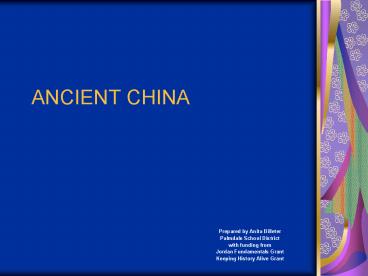ANCIENT CHINA - PowerPoint PPT Presentation
1 / 19
Title:
ANCIENT CHINA
Description:
Mountains and deserts separated regions in China and led them to develop ... The Han rulers combined Legalism with Confucianism to create a strong government ... – PowerPoint PPT presentation
Number of Views:66
Avg rating:3.0/5.0
Title: ANCIENT CHINA
1
ANCIENT CHINA
- Prepared by Anita Billeter
- Palmdale School District
- with funding from
- Jordan Fundamentals Grant
- Keeping History Alive Grant
2
GEOGRAPHY
- Mountains and deserts separated regions in China
and led them to develop separately from each
other. - Rivers serve to link the different regions.
- Flooding rivers provide minerals that enrich the
soil but also sometimes bring disaster.
3
EARLY CULTURES
- The Yangshao settled in farming villages and
built houses with plaster floors and roofs
supported by wooden posts. - The Lungshan farmers harvested silk, wove fabric,
made pottery, and used simple written symbols and
numbers.
4
- According to legend, a Lungshan engineer named Yu
founded the first great Chinese dynasty called
the Xia, around 2000 B.C.
5
THE SHANG DYNASTY
- The Shang Dynasty followed the Xia and ruled for
more than 700 years. - The Shang built some great walled cities,
developed bronze, devised a money system, and
developed a class of skilled artisans.
6
- The Shang people believed in an afterlife, many
gods, ancestor worship, and the use of oracle
bones to predict the future.
7
THE ZHOU DYNASTY
- Wu the Martial attacked the Shang king and
established the Zhou Dynasty, the longest in
Chinas history. - The Zhou worshiped tian, and established the
mandate of heaven as the right to rule.
8
- The Zhou spread their rule through feudalism, and
used a character-based written language to unify
communication.
9
AN AGE OF CHANGE
- Independent lords invaded the Zhou capital,
driving the Zhou rulers out. - The heads of the strongest feudal states became
the true rulers of China, and it was a time of
chaos. - During this period of unrest, a number of great
thinkers sought ways to put Chinese society back
in order. Confucious was one of these great
thinkers.
10
CONFUCIOUS
- Confucianism, a code of behavior, has influenced
Chinese thought for over 2,500 years. - Confucius taught that sincerity, loyalty, and
mutual respect should be the center of all
relationships, and that obedience to ones
parents was vital.
11
- Confucius taught that rulers should rule by good
example, and act like a father to his people. - Mencius spread the ideas of Confucianism.
12
OPPONENTS OF CONFUCIANISM
- Moists believed in equal love for all people, and
that such universal love would bring benefits,
such as peace. - Legalists believed people were naturally bad and
required a government of strict laws and harsh
punishments to keep their evil under control.
13
- Daoists believed human nature was neither good
nor bad, and that people should live a simple and
thoughtful life in harmony with nature.
14
The Qin Dynasty
- The king of the state of Qin conquered all other
feudal kings and became the first emperor of
China. - The emperor, Qin Shuhuangdi, worked to maintain
power over the many warring states by dividing
the empire into provinces with governors who
reported to him.
15
THE LEGACY OF QIN
- Qin ended the Chinese feudal system, and set up a
system of government by bureaucracy. - Qin determined a set standard measurements, set
one form of money, and decreed standard written
characters.
16
- Qin censored books and ideas that he believed
challenged his power. - Qin oversaw the building of the Great Wall, which
stretches for over 1,500 miles.
17
REVIVAL OF CONFUCIANISM
- The Qin government was harsh and was overthrown
and replaced by the Han dynasty in 206 B.C. - The Han lifted the ban on books and encouraged
the study of Confucianism. - The Han rulers combined Legalism with
Confucianism to create a strong government with
strict laws led by an emperor who set a good
example for his people.
18
DAILY LIFE IN THE EMPIRE
- Only one in 10 Chinese people lived in a city.
Most Chinese were farmers, living in the country. - Cities were centers of government, education,
entertainment, and trade.
19
ACHIEVEMENTS OF THE HAN DYNASTY
- Under the Han Dynasty, China expanded the Silk
Road trade, and invented the seismograph and
paper. - Han writers increased the number of Chinese
characters, and created the first Chinese
dictionary. - The Han civilization created important works in
medicine, mathematics, poetry, history, and art.































